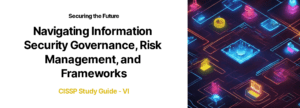Overview
Dive deep into the realm of Information Security Governance and Risk Management with our comprehensive presentation. Learn the essentials of safeguarding critical data through an exploration of concepts like confidentiality, integrity, and availability. Unravel the complexities of vulnerabilities, threats, and the steps necessary for robust personnel security practices.
Key Learning Outcomes
- Grasp the foundational principles of data protection, focusing on preventing unauthorized access, ensuring data reliability, and confirming its availability when needed.
- Identify the different aspects of security weaknesses, including vulnerabilities, threats, and threat agents, to reinforce your defense strategies.
- Understand the multi-dimensional nature of risk in information security, along with measures for evaluation and mitigation.
- Master the best practices in personnel security to minimize internal risks, including job rotation, separation of duties, and dual control strategies.
- Gain knowledge of key Information Security Frameworks—ISO/IEC 27000, Zachman, and TOGAF among others—and their applications for improving your security posture.
- Delve into Security Frameworks and methodologies like CMMI, and compare top-down versus bottom-up approaches to security initiatives.
- Walk through the Security Program Life Cycle stages, from planning and organization to monitoring and evaluation.
- Decode the pillars of risk assessment, distinguishing between asset identification, threat calculation, and the balance between countermeasure costs and asset value.
- Differentiate between quantitative and qualitative risk analysis methods to choose the one best suited for your organization’s needs.
- Analyze how to select safeguards effectively by measuring total and residual risks against the costs and benefits.
- Discover the essentials of creating and managing a risk management policy, and forming a dedicated team to oversee it.
- Build a robust security policy cycle, setting standards and baselines, and implementing guidelines for a secure information classification life cycle.
- Identify governance roles and security protocols, emphasizing the importance of security training and its impact on informed decision-making.
- Evaluate effective measurement techniques and learn how to design a security budget prioritizing risk management and cost-benefit considerations.
Conclusion
This presentation serves as a crucial guide for individuals and organizations seeking to strengthen their information security governance and risk management framework. The content is carefully curated to provide actionable insights and equip professionals with the tools to build a resilient security infrastructure.
Call to Action
Enhance your organization’s cybersecurity strategy by viewing or downloading this insightful presentation. For more information and resources on information security best practices, visit our InfoSec Knowledge Hub. Remember to reference our website appropriately for any use of this material.


